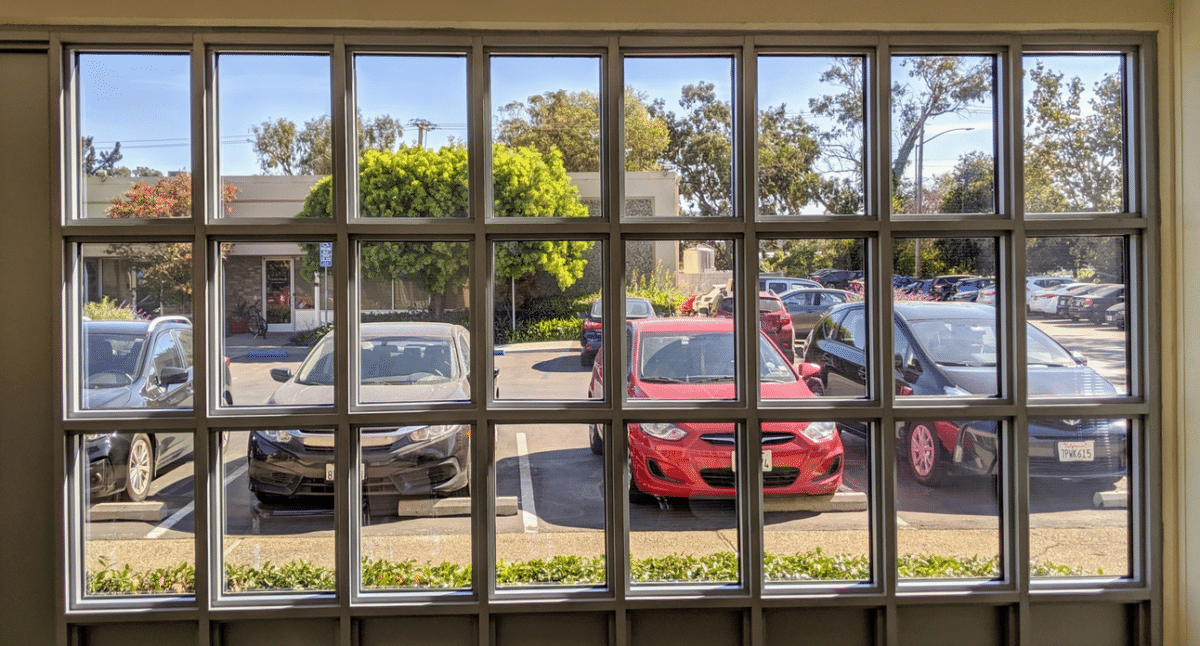Organic solar cells (OSCs) are lightweight, nontoxic and semi-transparent. They have long-held the promise of low-cost manufacturing, but their efficiencies tend to be low — and their long-term reliability has been questionable.
Ubiquitous Energy is building transparent solar windows with the material.
Ubiquitous Energy deposits organic layers directly on glass using standard glass coating equipment. According to the firm, the transparent solar coating selectively absorbs and converts ultraviolet and near-infrared light to electricity while letting visible light through. The firm is focusing its initial work on architectural glass. The Ubiquitous Energy team holds a number of patents in organic solar cells and graded solar cell technology.
Last year, Ubiquitous Energy claimed a world record for efficiency of a transparent solar cell with a 9.8% power conversion efficiency. The efficiency of the very small-sized organic solar cell was certified by private, third-party test lab Newport Corporation to keep its IP protected, according to Veeral Hardev, director of business development at Ubiquitous, in an interview with pv magazine.
Hardev expects the production window product to have an efficiency of 7% to 10%.
Ubiquitous Energy has raised more than $25 million from investors such as Riverhorse Investments, Arunas Chesonis, Aberdeen Worldwide Group, Cranberry Capital, along with grants from the National Science Foundation — since being spun-out from the MIT lab of Vladimir Bulović in 2011. Susan Casey Stone, a partner at Riverhorse Investments is CEO, having replaced previous CEO Keith Wilson of Cranberry Capital and Sweetwater Energy.
Big glass and the business plan
Ubiquitous wants to license its technology to big glass companies like Asahi Glass and Pilkington Glass.
But, when it comes to the glass and window industry, Hardev said, “These are conservative companies — and one of the things we’ve learned is how risk adverse they are. It has to work, be efficient and durable — and they still need to see large-size product before they move.”
This means that the startup will have to build a manufacturing facility over the next few years “to give the industry confidence.”
Passive curtain wall vs. PV curtain wall costs
Hardev gave his take on the economics of the product. He said that while it varies considerably, installed cost of curtain wall is on average $100 per square-foot. He suggests that photovoltaic curtain wall would cost 10% to 30% more — or $110 to $130 per square-foot including wiring. He believes that people in the glazing trade are familiar with more advanced and active curtain walls.
He said, “A solar panel that’s a window has to be treated like a solar panel,” and noted that some wiring schemes kept the facade in DC to power LEDs or used it to offset building management energy use.
A daunting marketing challenge
Commercializing an integrated solar facade is not just an engineering problem. It means driving a completely new type of window and curtain wall product through the very conservative building channel — and that’s a daunting marketing challenge.
Currently, global deployment of OSCs is negligible. Global production capacity amounts to just a few megawatts. OSCs have the lowest efficiency range of any NREL-listed materials system and have not yet delivered on their commercial or cost promise.
Hardev said he was confident in the company’s ability to scale up its product.
The firm has installed approximately 100 square feet of transparent solar windows at its headquarters in Redwood City, California as an exterior facing window façade replacing the previous single pane windows.
***
Current OSC companies
- Heliatek has raised more than $140 million since its founding in 2006 as a spinoff from the Universities of Dresden and Ulm. NREL’s record-keepers have Heliatek at about 10 percent for a single-layer device. Heliatek vacuum deposits layers of small-molecule oligomers at low temperatures in a process that doesn’t use solvents, as printing-based processes do. Heliatek’s funding comes from innogy, Engie, BASF, Stefan Quandt and others. A few years ago, Heliatek’s CEO told this reporter that its fab was producing cells with an efficiency of 8.2% and the next fab would be at 10%. In 2018, the company went through a management change.
- 3GSolar’s DSCs for wireless applications
- Opvius is the former Belectric OPV
- InfinityPV
- Other OSC researchers include Solarmer, Peccell, EPFL, Intel and Mitsubishi
- Oxford Photovoltaics, started with organic solar cells, but soon focused on perovskite materials.
Former OSC companies
- Dyesol claimed to be developing Dye Solar Cell (DSC) technology using a layer of nanotitania on a glass or metal substrate, then claimed to be a perovskite company — and then entered administration.
- Organic solar cell aspirant Konarka raised a great deal of money and went bankrupt without ever making it to commercial production. Its assets were acquired by Belectric.
- Ireland’s SolarPrint spent millions of dollars of investor money on a DSC process before going bankrupt in 2014.
- Eight19 Limited, now dormant, raised $7 million from the Carbon Trust and Rhodia to develop plastic organic solar cells, then switched to working on a “photon multiplier film.”
- Plextronics (bankrupt and sold to Solvay)
This content is protected by copyright and may not be reused. If you want to cooperate with us and would like to reuse some of our content, please contact: editors@pv-magazine.com.








Another consideration for BIPV in the very conservative building channel: Which trade will be responsible by contract to install windows and curtain walls that also happen to generate electrical power? IUPAT Glaziers, or IBEW electrical workers?
SunPartner Technology in France raised 70 M€, and finally bankrupted